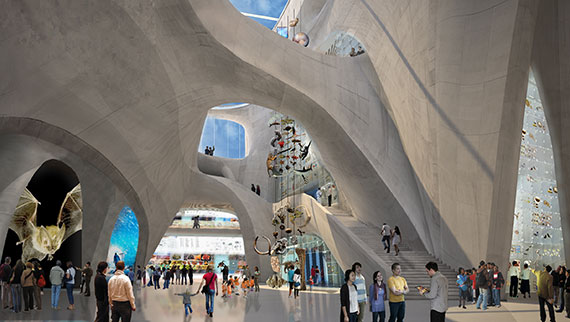Trending
An alien within
The museum’s new addition may</br> look tame on the outside, but the </br>inside recalls an ‘alien landscape’</br> or ‘fun house

Few people have been as kind to the Upper West Side as finance bigwig Richard Gilder, who sits on the boards of the New-York Historical Society and the neighboring American Museum of Natural History — and has given lavishly to both institutions. Indeed, only a few years ago, 77th Street from Columbus to Central Park West, the thoroughfare that separates the two museums, was officially renamed Richard Gilder Way.
Gilder, who founded an investment management firm bearing his name, has already contributed $125 million to the Museum of Natural History, of which $50 million will go to the construction of the Gilder Center. This new education and exhibit building will eventually cost $325 million — and roughly half of that has already been raised. If all goes according to plan, groundbreaking will take place in 2017, and the new center will open in late 2019, in time for the museum’s 150th anniversary.
While the new addition will have a good amount of classroom space, it will also allot more room for the museum’s existing collections, including a stellar display of insect specimens that has not been seen by the public in nearly half a century and the museum’s much-loved butterfly display. The center will also contain an “Invisible Worlds Theater,” described as “an immersive theater that will reveal new frontiers of scientific research” through new imaging technology.
Chicago-based Jeanne Gang of Studio Gang Architects designed the new project, which will stand at 79th Street, facing Columbus Avenue. To date, her most famous work is the 859-foot-tall Aqua, the Windy City’s third-tallest building. That building manages to stand out in a city renowned for its varied and excellent architecture. Its uniqueness is most ostentatiously seen through the flange-like balconies that irregularly run along its façade, recalling the famed Marina City complex that stands about half a mile to the west. If the newer Aqua reads as a postmodern or deconstructed riposte to that earlier building, it also reminds some of us New Yorkers of Frank Gehry’s New York by Gehry in Lower Manhattan. Both are essentially traditional rectilinear towers whose unconventional surface treatment aspires to breathe new life into a tired old typology. In this ambition, Studio Gang has been far more successful at Aqua than Gehry was: Its design penetrates its structure far more deeply, and in a far less arbitrary way, than Gehry’s does.
According to the renderings that the Museum of Natural History has released, a similarly fluid design sense will be borne out at the new Gilder Center.

The inside of the Gilder Center
In some ways, the new structure promises to be a variation on the museum’s iconic Rose Center for Earth and Space. Clearly the museum has set out to repeat the remarkable success of that earlier addition, which opened to the public in 2000. The Rose Center — designed by Todd Schliemann of Polshek Partnership Architects (since renamed Ennead) — was one of New York’s boldest structures, consisting of a seemingly perfect sphere contained within a perfect cube that was formed from an extensive glass curtain wall. It would be very hard to conjure up a form as striking as that, but Gang intends to try, and she may just be the one to do it.
Her Gilder Center presents itself as a glass box whose interior spaces, flooded with natural light, will become a theater of complicated and novel spatial interactions.
Unlike the almost prim geometric legibility of the Rose Center, here the space is dominated by a sinuous structure of stone and concrete bridges and dunes that recall some alien landscape and that are also weight bearing. One is hard pressed to think of any serious and permanent building that is comparable to what Gang has proposed here, which recalls the architecture of a fun house or some other amusement park-type structure. The design does, however improbably, recall I.M. Pei’s East Wing of the National Gallery in Washington, which like the Gilder Center design is rich in asymmetry and spatial complexity.
In what will be the latest intervention into Theodore Roosevelt Park, a public park that surrounds the museum from 77th to 81st streets and from Central Park West to Columbus, the Gilder Center would be the 11th building erected on the site. This is not a campus, of course, but a rather shapeless agglomeration of structures that are inharmonious. In this, it resembles the Metropolitan Museum directly across Central Park, although the Museum of Natural History’s buildings seem to have been combined in a far more ad hoc way than they are at the Met. Even the transition from the Rose Center to the main building is cumbersome and clumsy.
In all, 218,000 square feet will be added to the museum, although most of that will exist within its present footprint, extending only about a quarter of an acre into the surrounding park.
Both in its massing and its shape, the new addition will appear to fill something of a gap in the footprint of the Museum, bringing it a little closer to the Museum’s 1872 master plan, which foresaw something like the grand 77th Street façade replicated on all four sides. This will finally supply the museum with a grand entrance on Columbus, to complement those on Central Park West as well as 77th and 81st streets.
It must be said, however, that the exterior façade of the Gilder Center appears to be far less interesting than the interior. I would think that visitors who don’t know what they’re walking into might be astonished that something so bold could lie hidden within. Its grayish, seven-story structure is largely level with the two contiguous structures that flank it, but their interaction is hardly smooth. In itself, however, it is conceived in accordance with the tame asymmetries and well-behaved irregularities of the latest worldwide corporate architecture.
But as befits a history museum, it may be appropriate that the interior bones of this new creature will prove more prepossessing than its modest exterior.




